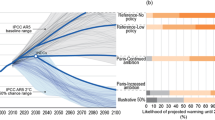Abstract
In this paper, the panel data of industrial CO\(_2\) emissions among 31 provincial regions in China from 1985 to 2010 are utilized to analyze the nonlinear relationship between industrial pollution and economic development level based on nonparametric method for testing and verifying the environmental Kuznets hypothesis of carbon dioxide (CKC) in China. The industrial carbon dioxide emissions and GDP per capita are as measures of the industrial pollution and the level of economic development. The nonlinear methods have much more flexibility than linear model because there is no linear hypothesis, which may lead to the problem of model misspecification. Thus, nonlinear methods can obtain more accurate and effective results. Our results show that the nonlinear relationship between the industrial carbon dioxide emissions and the level of economic development has an inverted-U shape, which is the pattern of CKC curves. Moreover, Shanghai, Beijing and Tianjin have crossed the CKC inflection point and are now in developmental stage of environmental pollution reduced since 2005, 2006 and 2008 respectively. However, other areas are still in the earlier stage of environmental pollution, economic growth is accompanied by the tendency towards worsening environmental pollution.






Similar content being viewed by others
Notes
CO\(_2\)pc and GDPpc indicate CO\(_2\) per capita and GDP per capita.
We adopted the data from Chen (2012).
References
Agras, J., & Chapman, D. (1999). A dynamic approach to the environmental Kuznets curve hypothesis. Ecological Economics, 28, 267–277.
Arrow, K., Bolin, B., Costanza, R., Dasgupta, P., Folke, C., Holling, C. S., et al. (1995). Economic growth, carrying capacity, and the environment. Ecological Economics, 15, 91–95.
Azomahou, T., Laisney, F., & Phu, N. V. (2006). Economic development and CO2 emissions: A nonparametric panel approach. Journal of Public Economics, 90, 1347–1363.
Bartz, S., & Kelly, D. L. (2008). Economic growth and the environment: Theory and facts. Resource and Energy Economics, 30, 115–149.
Bertinelli, L., & Strobl, E. (2005). The environmental Kuznets curve semi-parametrically revisited. Economics Letters, 88, 350–357.
Chen, Shiyi. (2012). Evaluation of low carbon transformation process for chinese provinces. Economic Research Journal, 8, 32–44.
Cole, M. A. (2004). US environmental load displacement: Examining consumption, regulations and the role of NAFTA. Ecological Economics, 48(4), 439–450.
Cole, M. A., Rayner, A. J., & Bates, J. M. (1997). The environmental Kuznets curve: An empirical analysis. Environmental and Development Economics, 2, 401–416.
Dasgupta, Susmita, Laplante, Benoit, Wang, Hua, & Wheeler, David. (2002). Confronting the environmental Kuznets curve. The Journal of Economic Perspectives, 16, 147–168.
Friedman, J. H., & Stuetzle, W. (1981). Projection pursuit regression. Journal of the American Statistical Association, 76, 817–823.
Galeotti, M., & Lanza, A. (1999). Richer and cleaner? A study on carbon dioxide emissions in developing countries. Energy Policy, 27, 565–573.
Galeotti, M., Lanza, A., & Pauli, F. (2006). Reassessing the environmental Kuznets curve for CO\(_2\) emission: A robustness exercise. Ecological Economics, 57, 152–163.
Grossman, G. M., & Krueger, A. B. (1991). Environmental Impacts of a North American Free Trade agreement. National Bureau of Economic Research Working Paper, Vol. 3914. NBER, Cambridge, MA.
Grossman, G. M., & Krueger, A. B. (1995). Economic growth and the environment. Quarterly Journal of Economics, 110, 353–377.
He, J., & Richard, P. (2010). Environmental Kuznets curve for CO\(_2\) in Canada. Ecological Economics, 69, 1083–1093.
Heil, M. T., & Selden, T. M. (2001). Carbon emissions and economic development: Future trajectories based on historical experience. Environment and Development Economics, 6, 63–83.
Holtz-Eakin, D., & Selden, T. M. (1995). Stoking the fires? CO\(_2\) emissions and economic growth. Journal of Public Economics, 57, 85–101.
Huang, H. C. (2004). A flexible nonlinear inference to the Kuznets hypothesis. Economics Letters, 84, 289–296.
Maddison, D. J. (2006). Environmental Kuznets curves: A spatial econometric analysis. Journal of Environmental Economics and Management, 51, 218–230.
Maplecroft (2011). The climate change vulnerability index. Verisk Maplecroft indices and maps, Verisk Maplecroft.
Martinez-Zarzoso, I., & Bengochea-Morancho, A. (2004). Pooled mean group estimation for an environmental Kuznets curve for CO\(_2\). Economic Letters, 82(1), 121–126.
Nguyen-Van, P. (2010). Energy consumption and income: A semiparametric panel data analysis. Energy Economics, 32, 557–563.
Panayotou, T. (1993). Empirical tests and policy analysis of environmental degradation at different stages of economic development. Working Paper WP238 Technology and Employment Programme. International Labor Office, Geneva.
Roca, J., Padilla, E., Farré, M., & Galletto, V. (2001). Economic growth and atmospheric pollution in Spain: Discussion the environmental Kuznets hypothesis. Ecological Economics, 39, 85–99.
Selden, T. M., & Song, D. (1994). Environmental quality and development: is there a Kuznets curve for air pollution emissions. Journal of Environmental Economics and Management, 27, 147–162.
Sengupta, E. (1996). CO2 emission-income relationship: Policy approach for climate control. Pacific and Scian Journla of Energy, 7, 207–229.
Schuster, A. (1898). On the investigation of hidden periodicities with application to a supposed 26 day period of meteorological phenomena. Terrestrial Magnetism and Atmospheric Electricity, 3, 13–41.
Shafik, N., & Bandyopadhyay, S. (1992) Economic growth and environmental quality: time-series and cross-country evidence. World Development Report Working Paper WPS 904, The World Bank, Washington, DC.
Stern, D. I. (1998). Progress on the environmental Kuznets curve? Environment and Development Economics, 3, 173–196.
Taskin, F., & Zaim, O. (2000). Searching for a Kuznets curve in environmental efficiency using kernel estimation. Economics Letters, 68, 217–223.
York, R., et al. (2003). STIRPAT, IPAT and ImPACT: analytic tools for unpacking the driving forces of environmental impacts. Ecological Economics, 46, 351–365.
Zhang, J., Wu, G., & Zhang, J. (2004). Estimating provincial capital stock in China. Economic Research, 10, 35–44.
Acknowledgments
Shiyi Chen acknowledges the support from Chang Jiang Scholars Program of Education Ministry, National Social Science Foundation (Major Program: 14ZDB144; Key Program: 12AZD047), National Natural Science Foundation (71173048), Shanghai Leading Talent Project and Fudan Zhuo-Shi Talent Plan.
Author information
Authors and Affiliations
Corresponding author
Rights and permissions
About this article
Cite this article
Chen, L., Chen, S. The Estimation of Environmental Kuznets Curve in China: Nonparametric Panel Approach. Comput Econ 46, 405–420 (2015). https://doi.org/10.1007/s10614-015-9486-7
Accepted:
Published:
Issue Date:
DOI: https://doi.org/10.1007/s10614-015-9486-7




